A pair of my favourite Ferguson and Massey Ferguson tractors!
Posted by Chris Graham on 1st March 2024
Jonathan Whitlam meets James Issitt to find out more about his passion for Ferguson and Massey Ferguson tractors.
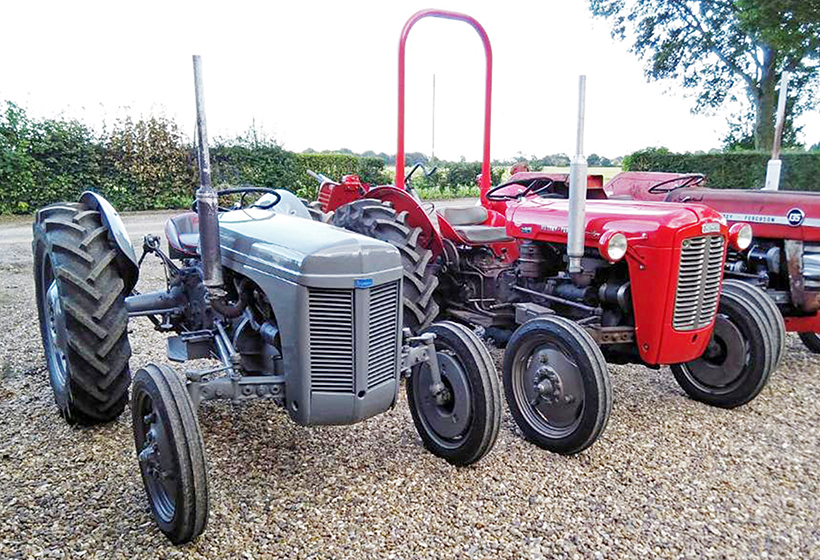
James Issitt’s collection of small Ferguson and Massey Ferguson tractors, with his 135 to the right. Note the front wheel weights fitted to the Ferguson TE-A 20 and the MF 35.
James Issitt owns several Massey Ferguson tractors in his collection in south Lincolnshire. The oldest – and the very first he ever owned – is a Ferguson TE-A 20, and a very fine example of what we might now call the second version of the TE-20, it is too!
James found it on the internet 10 years ago, being sold by someone near Tamworth. He rang the seller and found that it was indeed still for sale, but the next problem was getting from Lincolnshire to view it. However, as a truck driver, the following week he had a load of timber to take from the north to the Midlands, so it was pretty easy to make a slight detour to view the tractor.
Initial findings
It started and ran more or less OK. The tyres were perished, although the tinwork was very straight, albeit showing its age. So, now there was a new problem – how to get the tractor home! That meant a chat with the boss!
Fortunately, James and his employer get on very well, and so it was arranged that when the next load was scheduled for delivery in that area, the tractor could be collected and brought back on the empty lorry. So, as things turned out, James’ first tractor purchase was actually extremely straightforward, simple and relatively inexpensive.
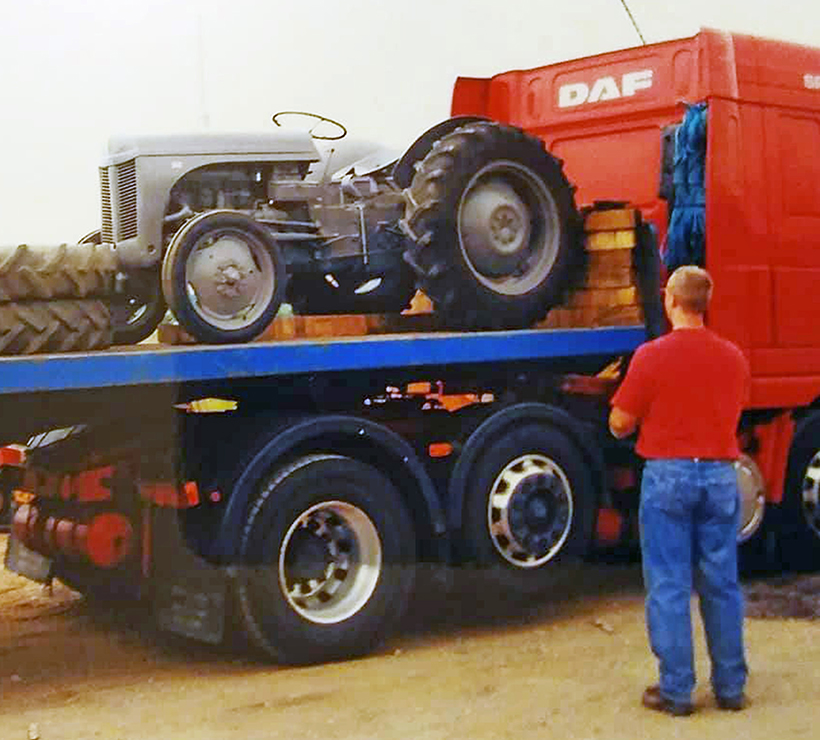
An exciting day! The Ferguson TE-A 20 arrives at its new Lincolnshire home.
Once the tractor was safely in Lincolnshire, it was time for the first proper appraisal. It was clear that the machine had actually had quite a lot done to it over the years, including a coat of new paint, so there was no immediate rush to get any major work done. Therefore, James decided that the first thing to do was to sort out an age-related registration number.
James believes that his grey Fergie has been fitted with a later engine although, given that there’s been no need to take the tractor apart, he isn’t absolutely certain about that yet. “What I mean by that,” he explained, “is that the Standard Motor Company engines for the TE-A and TE-D 20s had 80mm or 85mm bores. Later on, petrol-powered 35s – and the Massey baler that had its own engine to drive it – used an 87mm bore motor, fitted with a Zenith 28G carburettor instead of a Zenith 24T.
“The difference is quite noticeable, with mid-range and top end making the tractor a little thirsty when it’s worked hard. On slow idle, the engine is falling over itself and sounds like a tuned 1970s or ‘80s car engine, with a different camshaft burbling away! It has a totally different exhaust note than both the 80mm and 85mm bore engine, and you certainly notice it when working.”
TE-A 20 developments
The TE-A 20 replaced the original TE-20 model that had been produced at Banner Lane in Coventry since 1946, with the Standard Motor Company building them in the earliest days. The TE-A 20 looked the same externally, although it was fitted with a new engine. Originally, a four-cylinder Continental petrol-powered unit producing 23hp had been used, but, in 1947, the new TE-A 20 appeared; its new model designation signifying the use of a Standard Motor Company four-cylinder unit of 25hp.
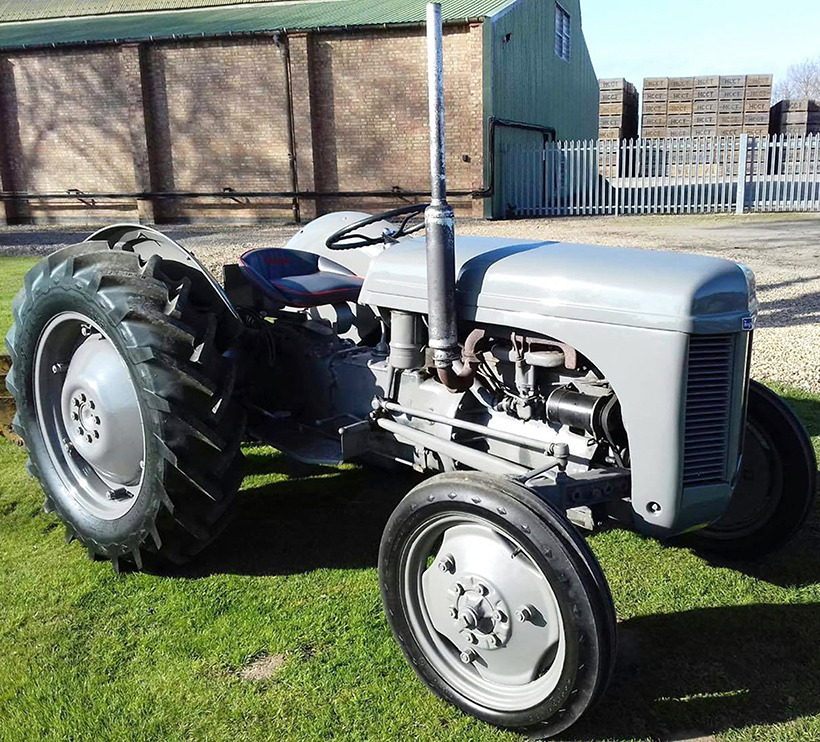
Looking resplendent on a sunny day, this Ferguson TE-A 20 has been carefully restored to its present condition.
Although introduced in 1947 with pre-production units produced, it wasn’t until nearly the end of January 1948 before the TE-A 20 production got underway, alongside Continental-engined versions that were still being built during that year. A few modifications had to be made to solve some initial teething troubles, and, as with the original TE-20, a four-speed transmission was fitted.
The TE-A 20 remained on offer despite the success of the other fuelled versions such as TVO and, later still, the diesel. Eventually, though, diesel became the most popular choice with the TE-F 20 version, as it was the cheaper fuel.
James has used his Ferguson for ploughing – with a three-furrow, semi-digger on the back – without any problems, illustrating the capabilities of the engine. He’s even had a four-furrow on the back, although he admitted that the hydraulics weren’t keen on lifting that one! Nevertheless, he was able to manage some shallow ploughing at a working day, purely as a demonstration of the tractor’s prowess!
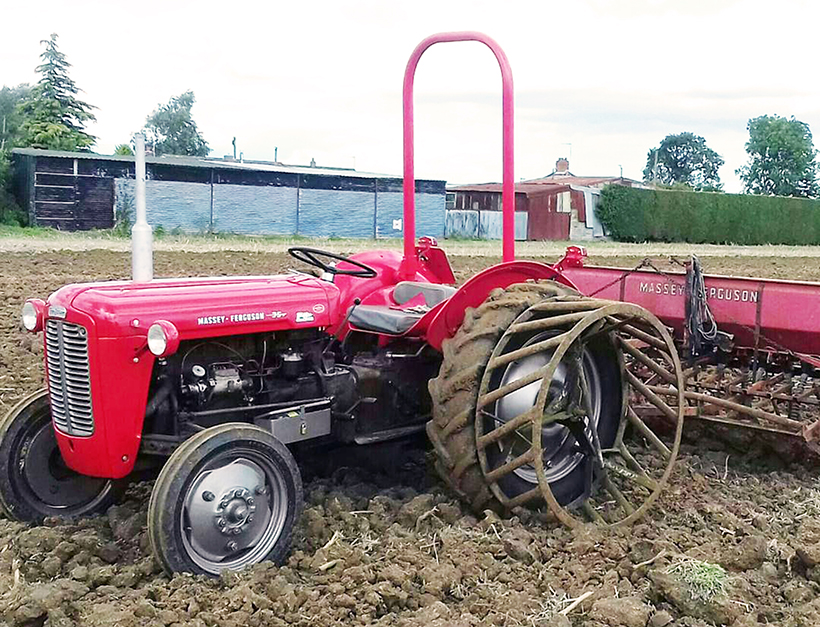
Fitted with cage wheels, the 35 looks superb coupled to an MF seed drill. This model has the Standard, four-cylinder diesel engine, but James says starting isn’t the huge issue it’s often made out to be, assuming the engine is well maintained.
To James, the little grey Fergie is pretty much a toy, so it doesn’t get worked on the family’s farm. Instead, he likes to blow away the cobwebs with it on road runs and at local working days. Nevertheless, he’s adamant that it remains a very capable machine, and it’s clear that James has a great deal of fondness for this old machine.
Going red!
The companion to the Ferguson TE-A 20 in James’s collection is a red and flint grey, four-cylinder Massey Ferguson 35, which, as it’s a very early 1958 example, really is, to all intents and purposes, still a Ferguson FE 35 in a smart new set of clothes.
Replacing the TE-20 model range in 1956, the Ferguson FE 35 owed more to the Ferguson tractors in North America than it did to the models coming out of Coventry. Based on the TO-35, it included an improved hydraulic system, improved Standard Motor Company engines and new tinwork, which was accentuated by a new grey and gold colour scheme.
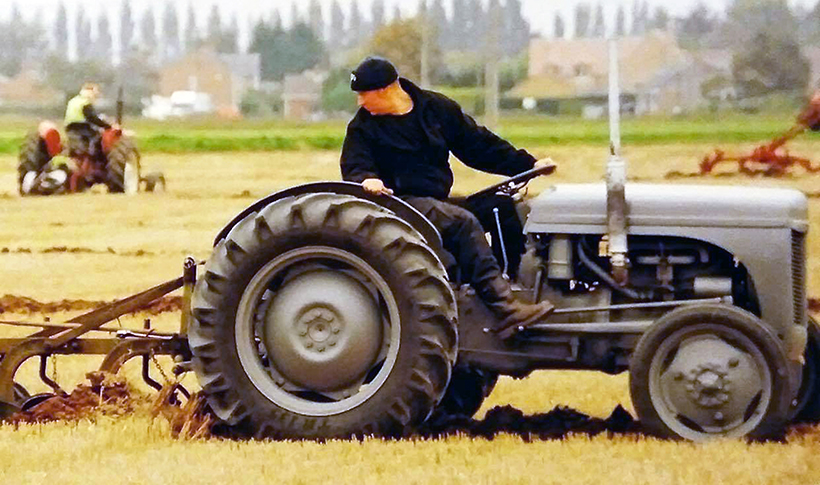
James taking part in a ploughing match with his Ferguson TE-A 20. He considers it to be a very capable machine.
In 1953, the Ferguson operation was merged with Massey-Harris and then, in December 1957, a company reorganisation resulted in the creation of Massey Ferguson Ltd. This led to the Ferguson FE-35 being re-launched as the Massey Ferguson 35 at the Smithfield Show that year, resplendent in a smart new, red and grey livery. Production of the new-look 35 began in earnest in early 1958, with James’s tractor being one of these early machines.
This tractor spent all its working life in Cambridgeshire, before moving to James’s home in Lincolnshire. “And yes, it starts fine!” James added referring, of course, to the fact that the engines in these tractors are notorious for being difficult to get going.
“Unfortunately, these engines are critical on timing and high compression,” James elaborated. “There’s no need for four heater plugs; these are only required for Scotland or Scandinavia, where the weather can be rather more extreme. If full heating is required to start an engine in ‘normal’ temperatures, then there’s some serious wear in the engine, somewhere”.
A unique sound
James also mentioned that these engines produce a nice, metallic exhaust note; a sound that’s unique to the model. It’s different even from the Allis-Chalmers ED40, which used the same motor. “I suppose that the grey and gold FE 35, which was identical to my red and grey 35 (apart from two or three minor details), was much better than the original TE-20,” James said. “For a start, you have a six-speed transmission, and when that’s added to the fantastic hydraulics, independent brakes plus more horsepower and torque, well, these are obviously far superior tractors to their predecessors.”

The 35, dating from early 1958, is still used a great deal for various tasks, including taking part in ploughing matches and working days.
So how did James find this particular tractor then? “Well, I had sold a Ford pick-up hitch to someone, and when I delivered it, I was asked (as you often are) if I’d like to see the chap’s collection of tractors? Among the Fords was this 35 which, at that stage, was about one-third restored. I said that I really liked it and asked if it was for sale? Unfortunately, it wasn’t, so I left, suggesting that, if it ever was, he should get in touch.
“More than 12 months later I received a call with the news that the 35 was now available and that, if I was still interested, I’d better arrange to collect it. Now, as it happened, I’d just bought a Ford 3000 but had been rather disappointed with it and so had put it up for sale. A week later, at 11am on a Saturday morning, my Ford 3000 was on a trailer and ready for the journey to its new home, and shortly after that, I was the owner of a four-cylinder MF 35!”

Coupled to a Pettit trailer the Ferguson badge can clearly be seen on the front of the tractor, instead of the triple-triangle badge that came later.
These days, the 35 does rather more work than the older TE-A 20, and James is fairly well kitted-out, having a set of cage wheels for it, plus auxiliary hydraulic service out and return feeds, full lighting kit, foldable roll-over frame as well as MF inside-mounted rear wheel weights. The 35 does a bit of ploughing and is also often used for trailer work, coupled to a three-ton Pettit deluxe.
James has a few cultivators and an eight-foot set of disc harrows, but he usually uses those with another, smaller tractor; one that’s from a newer generation, but still red and grey. That, however, is another story.
This feature comes from the latest issue of Classic Massey & Ferguson Enthusiast, and you can get a money-saving subscription to this magazine simply by clicking HERE

Previous Post
The amazing record of 1940s battleship USS Wisconsin
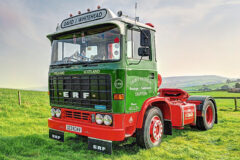
Next Post
1979 ERF B-Series lorry amazingly restored in the back garden!



